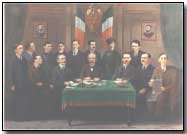 James Joyce in Paris 1924 - Potrait by Patrick Tuohy
James Joyce in Paris 1924 - Potrait by Patrick TuohyJames Augustine Aloysius Joyce (2 February 1882 – 13 January 1941) was an Irish writer and poet, widely considered to be one of the most influential writers of the 20th century. Along with Marcel Proust, Virginia Woolf, and others, Joyce was a key figure in the development of the modernist novel. He is best known for his landmark novel Ulysses (1922). Other major works are the short-story collection Dubliners (1914), and the novels A Portrait of the Artist as a Young Man (1916) and Finnegans Wake (1939).
Though most of Joyce's adult life was spent in continental Europe, his fictional universe does not extend much beyond Dublin and is populated largely by characters who closely resemble family members, enemies and friends from his time there; Ulysses in particular is set with precision in the real streets and alleyways of the city. Shortly after the publication of Ulysses he elucidated this preoccupation somewhat, saying, "For myself, I always write about Dublin, because if I can get to the heart of Dublin I can get to the heart of all the cities of the world. In the particular is contained the universal."
Joyce set himself to finally finishing Ulysses in Paris, delighted to find that he was gradually gaining fame as an avant-garde writer. A further grant from Miss Shaw Weaver meant he could devote himself full-time to writing again, as well as consort with other literary figures in the city. During this era, Joyce's eyes began to give more and more problems. He was treated by Dr Louis Borsch in Paris, receiving nine surgeries from him until Borsch's death in 1929. Throughout the 1930s he traveled frequently to Switzerland for eye surgeries and treatments for Lucia, who, according to the Joyces, suffered from schizophrenia. Lucia was analysed by Carl Jung at the time, who after reading Ulysses, concluded that her father had schizophrenia. Jung noted that she and her father were two people heading to the bottom of a river, except that he was diving and she was falling.
In Paris, Maria and Eugene Jolas nursed Joyce during his long years of writing Finnegans Wake. Were it not for their unwavering support (along with Harriet Shaw Weaver's constant financial support), there is a good possibility that his books might never have been finished or published. In their now legendary literary magazine "Transition," the Jolases published serially various sections of Joyce's novel under the title Work in Progress. He returned to Zürich in late 1940, fleeing the Nazi occupation of France.
On 11 January 1941, he underwent surgery for a perforated ulcer. While at first improved, he relapsed the following day, and despite several transfusions, fell into a coma. He awoke at 2 a.m. on 13 January 1941, and asked for a nurse to call his wife and son before losing consciousness again. They were still on their way, when he died, 15 minutes later. He is buried in the Fluntern Cemetery within earshot of the lions in the Zürich Zoo.
Although two senior Irish diplomats were in Switzerland at the time, neither attended Joyce's funeral, and the Irish government subsequently declined Nora's offer to permit the repatriation of Joyce's remains. Nora, whom Joyce had finally married in London in 1931, survived him by 10 years. She is buried now by his side, as is their son George, who died in 1976. Ellmann reports that when the arrangements for Joyce's burial were being made, a Catholic priest tried to convince Nora that there should be a funeral Mass. She replied, "I couldn't do that to him." Swiss tenor Max Meili sang Addio terra, addio cielo from Monteverdi's L'Orfeo at the funeral service.

No comments:
Post a Comment